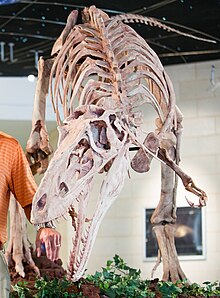Alioramus
Alioramus is a genus of tyrannosaurid dinosaur. It was about 20 feet long. It lived during the Upper Cretaceous period in what is now Mongolia.
| Alioramus Temporal range: Maastrichtian ~ | |
|---|---|
 | |
| Skeleton mount at Texas A&M University-Commerce | |
| Scientific classification | |
| Domain: | Eukaryota |
| Kingdom: | Animalia |
| Phylum: | Chordata |
| Clade: | Dinosauria |
| Clade: | Saurischia |
| Clade: | Theropoda |
| Family: | †Tyrannosauridae |
| Tribe: | †Alioramini |
| Genus: | †Alioramus Kurzanov 1976 |
| Type species | |
| †Alioramus remotus Kurzanov 1976 | |
| Species | |
| |
| Synonyms | |
| |
The type species, A. remotus, is known from a partial skull and three foot bones. They were got from Mongolian sediments which were deposited in a humid floodplain about 70 million years ago.[2] A second species, A. altai, known from a much more complete skeleton, was named and described in 2009.[3] Its relationships to other tyrannosaurid genera are unclear. Some evidence suggests that Alioramus is closely related to the contemporary species Tarbosaurus bataar.
Wetter climate
The Maastrichtian stage in Mongolia had a wetter and more humid climate than the previous stages. Sediments show there were floodplains, large river channels and soil deposits, with periodic droughts.[4]
This animal had many teeth, which were smaller than usual in the Tyrannosauridae, and a narrow, lower skull. It may have been a sub-adult (teenager), and must have eaten different prey than Tyrannosaurus. Since the general area was a riverine delta, the prey may have been fish.